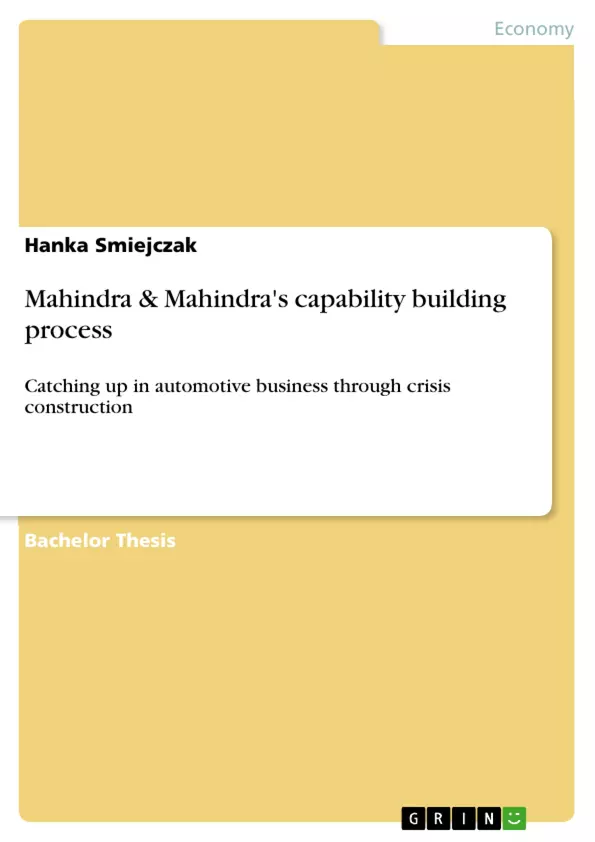
Mahindra & Mahindra's capability building process
Bachelorarbeit, 2011
83 Seiten, Note: 1,0
Leseprobe
Table of Contents
- 1. Introduction
- 2. Literature Review
- 3. Case Introduction
- 3.1 Industry Overview
- 3.2 Company Portrait and History
- 4. Crisis Construction and Capability Building Process
- 4.1 First Crisis: Economic Liberalization and Competitive Shock
- 4.2 Second Crisis: Reinventing the Automotive Business
- 4.3 Third Crisis: Going Global
- 4.4 Fourth Crisis: Becoming a Technological Leader?
- 5. Analysis, Discussion and Propositions
- 5.1 Analyzing the Setup, Execution and Outcome of Constructed Crises
- 5.2 Discussing Crisis Construction as a Tool for Pioneering
- 5.3 Concluding Remarks and Suggestions for Further Research
Objectives and Key Themes
This case study aims to contribute to the ongoing discussion regarding latecomer multinational companies from emerging markets, focusing specifically on Mahindra & Mahindra in India. It investigates the "crisis construction" model as a means for catching up in the automotive industry, analyzing the company's development through four distinct phases between 1990 and 2010. The study seeks to assess the applicability of Kim's model to other companies and contexts, proposing improvements to its classification of crises and evaluation of outcomes. It also explores the limitations of the model for pioneering companies.
- Latecomer multinational companies from emerging markets
- The "crisis construction" model for catching up
- Mahindra & Mahindra's development phases and strategies
- Applicability and limitations of the crisis construction model
- Technological catch-up, internationalization, and organizational learning
Chapter Summaries
1. Introduction: This chapter introduces the context of latecomer multinational companies from emerging markets, highlighting the rise of Indian firms and the importance of understanding their strategies for global competition. It sets the stage by discussing the economic liberalization in Asia and the subsequent emergence of new business models. The study focuses on Mahindra & Mahindra, a major Indian automobile conglomerate, to investigate its approach to achieving global standards within the rapidly developing Indian economy and its automotive sector. The chapter establishes the case study's objective: to contribute to the theoretical understanding of latecomer strategies rather than to test an existing theory.
2. Literature Review: This chapter (details not provided in the text excerpt) would likely review existing academic literature on latecomer firms, emerging markets, and the strategies employed by such companies to compete globally. It would lay the groundwork for the case study by providing a theoretical framework and identifying relevant concepts and models from existing research. This review would likely draw on previous studies of East Asian companies and provide a comparative context for understanding Mahindra & Mahindra's experiences.
3. Case Introduction: This section provides a detailed overview of the Indian automobile industry and Mahindra & Mahindra's history. The industry overview would likely analyze market trends, competitive dynamics, and government policies shaping the sector. The company portrait and history would detail Mahindra & Mahindra's origins, evolution, and key milestones. This chapter establishes the contextual backdrop for the subsequent analysis of Mahindra & Mahindra's strategic responses to various challenges and opportunities.
4. Crisis Construction and Capability Building Process: This chapter would analyze Mahindra & Mahindra's development through four distinct crises, examining how the company responded to each challenge and built its capabilities. Each crisis (economic liberalization, reinventing the business model, globalization, and becoming a technological leader) would be discussed in detail, exploring the specific strategies adopted, their effectiveness, and their contribution to the company's overall development trajectory. The analysis will incorporate details about the company's technological catch-up, its internationalization efforts, and its organizational learning process. This forms the core of the thesis, explaining how Mahindra & Mahindra applied the crisis construction model.
5. Analysis, Discussion and Propositions: This chapter would analyze the case study findings, discussing the strengths and weaknesses of the crisis construction model in the context of Mahindra & Mahindra's experience. It would assess the success of the company's strategies in relation to the model's framework, drawing conclusions on the applicability and limitations of crisis construction for catching up and for pioneering companies. This section would also likely offer suggestions for improving the model and directions for further research based on the insights gained from the case study. The chapter would likely integrate various frameworks and models to provide a comprehensive assessment of the company's capabilities and development.
Keywords
Latecomer firms, emerging markets, crisis construction, capability building, Mahindra & Mahindra, Indian automobile industry, technological catch-up, internationalization, organizational learning, competitive advantage, globalization, strategic management.
Mahindra & Mahindra Case Study: Frequently Asked Questions (FAQ)
What is the main focus of this case study?
This case study analyzes Mahindra & Mahindra's development from 1990 to 2010, focusing on how it utilized the "crisis construction" model to become a global player in the automotive industry. It examines the company's strategic responses to four distinct crises, assessing the applicability and limitations of this model for latecomer multinational companies from emerging markets.
What is the "crisis construction" model?
The "crisis construction" model is a strategic approach where companies intentionally create or utilize crises as catalysts for organizational change and capability building. This case study investigates how Mahindra & Mahindra leveraged this model to overcome challenges and achieve significant growth.
What are the key themes explored in the study?
The study explores several key themes, including: latecomer multinational companies from emerging markets; the "crisis construction" model for catching up; Mahindra & Mahindra's development phases and strategies; the applicability and limitations of the crisis construction model; technological catch-up, internationalization, and organizational learning.
What are the four crises analyzed in the case study?
The case study analyzes four distinct crises faced by Mahindra & Mahindra: 1) Economic liberalization and competitive shock; 2) Reinventing the automotive business; 3) Going global; and 4) Becoming a technological leader. Each crisis is examined in detail to understand the company's responses and the resulting capabilities built.
What is the significance of Mahindra & Mahindra in this study?
Mahindra & Mahindra serves as a prime example of a successful latecomer multinational company from an emerging market. The study uses its experience to illustrate the application and effectiveness of the "crisis construction" model.
What are the key findings of the study?
The study's findings will assess the success of Mahindra & Mahindra's strategies in relation to the crisis construction model. It will identify the strengths and weaknesses of the model, drawing conclusions about its applicability and limitations for both catching-up and pioneering companies. This will include evaluating the effectiveness of the company's technological catch-up, internationalization efforts, and organizational learning process.
What are the contributions of this case study?
The case study contributes to the theoretical understanding of latecomer strategies in emerging markets. It provides insights into the applicability and limitations of the "crisis construction" model, suggesting potential improvements and offering directions for future research.
What is the structure of the case study?
The case study is structured into five chapters: 1) Introduction; 2) Literature Review; 3) Case Introduction (Industry Overview and Company Portrait); 4) Crisis Construction and Capability Building Process; and 5) Analysis, Discussion and Propositions. Each chapter provides a specific contribution to the overall analysis.
Who would benefit from reading this case study?
This case study will benefit academics, researchers, and students interested in strategic management, international business, emerging market companies, and the application of innovative strategic models.
Where can I find more detailed information about the case study?
The provided text offers a comprehensive language preview, including chapter summaries and key themes. For the complete study, you would need to access the full publication.
Details
- Titel
- Mahindra & Mahindra's capability building process
- Untertitel
- Catching up in automotive business through crisis construction
- Hochschule
- Hochschule für Wirtschaft und Recht Berlin
- Veranstaltung
- International Business Management
- Note
- 1,0
- Autor
- Hanka Smiejczak (Autor:in)
- Erscheinungsjahr
- 2011
- Seiten
- 83
- Katalognummer
- V188498
- ISBN (eBook)
- 9783656121817
- ISBN (Buch)
- 9783656122807
- Dateigröße
- 1928 KB
- Sprache
- Englisch
- Schlagworte
- mahindra catching
- Produktsicherheit
- GRIN Publishing GmbH
- Preis (Ebook)
- US$ 40,99
- Preis (Book)
- US$ 52,99
- Arbeit zitieren
- Hanka Smiejczak (Autor:in), 2011, Mahindra & Mahindra's capability building process, München, Page::Imprint:: GRINVerlagOHG, https://www.diplomarbeiten24.de/document/188498
- Autor werden
- Ihre Optionen
- Vertriebskanäle
- Premium Services
- Autorenprofil
- Textarten und Formate
- Services für Verlage, Hochschulen, Unternehmen

- © GRIN Publishing GmbH.
- Alle Inhalte urheberrechtlich geschützt. Kopieren und verbreiten untersagt.
- info@grin.com
- AGB
- Open Publishing
Der GRIN Verlag hat sich seit 1998 auf die Veröffentlichung akademischer eBooks und Bücher spezialisiert. Der GRIN Verlag steht damit als erstes Unternehmen für User Generated Quality Content. Die Verlagsseiten GRIN.com, Hausarbeiten.de und Diplomarbeiten24 bieten für Hochschullehrer, Absolventen und Studenten die ideale Plattform, wissenschaftliche Texte wie Hausarbeiten, Referate, Bachelorarbeiten, Masterarbeiten, Diplomarbeiten, Dissertationen und wissenschaftliche Aufsätze einem breiten Publikum zu präsentieren.
Kostenfreie Veröffentlichung: Hausarbeit, Bachelorarbeit, Diplomarbeit, Dissertation, Masterarbeit, Interpretation oder Referat jetzt veröffentlichen!
- GRIN Verlag GmbH
-
- Nymphenburger Str. 86
- 80636
- Munich, Deutschland
- +49 89-550559-0
- +49 89-550559-10
- info@grin.com
-









